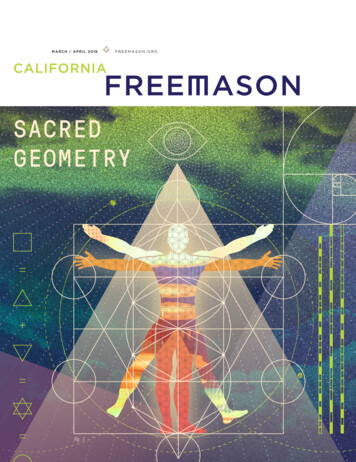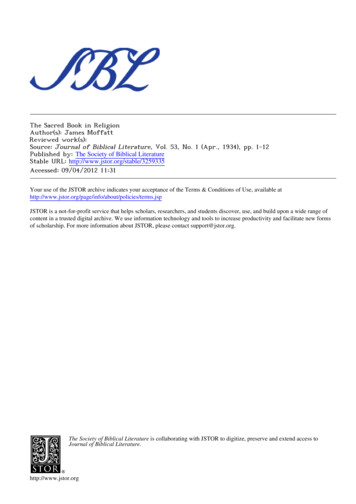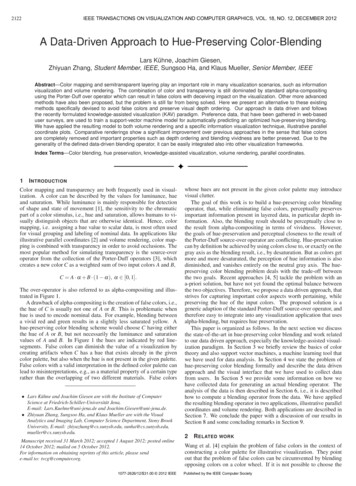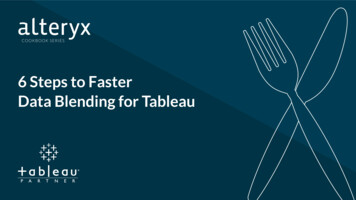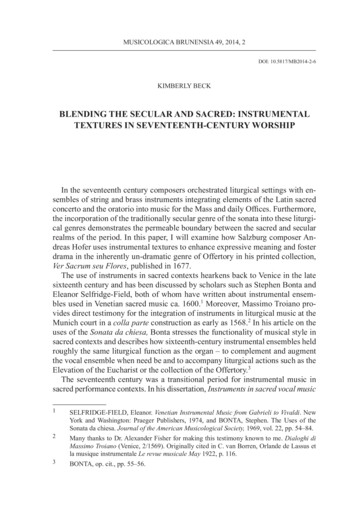
Transcription
MUSICOLOGICA BRUNENSIA 49, 2014, 2DOI: 10.5817/MB2014-2-6KIMBERLY BECKBLENDING THE SECULAR AND SACRED: INSTRUMENTALTEXTURES IN SEVENTEENTH-CENTURY WORSHIPIn the seventeenth century composers orchestrated liturgical settings with ensembles of string and brass instruments integrating elements of the Latin sacredconcerto and the oratorio into music for the Mass and daily Offices. Furthermore,the incorporation of the traditionally secular genre of the sonata into these liturgical genres demonstrates the permeable boundary between the sacred and secularrealms of the period. In this paper, I will examine how Salzburg composer Andreas Hofer uses instrumental textures to enhance expressive meaning and fosterdrama in the inherently un-dramatic genre of Offertory in his printed collection,Ver Sacrum seu Flores, published in 1677.The use of instruments in sacred contexts hearkens back to Venice in the latesixteenth century and has been discussed by scholars such as Stephen Bonta andEleanor Selfridge-Field, both of whom have written about instrumental ensembles used in Venetian sacred music ca. 1600.1 Moreover, Massimo Troiano provides direct testimony for the integration of instruments in liturgical music at theMunich court in a colla parte construction as early as 1568.2 In his article on theuses of the Sonata da chiesa, Bonta stresses the functionality of musical style insacred contexts and describes how sixteenth-century instrumental ensembles heldroughly the same liturgical function as the organ – to complement and augmentthe vocal ensemble when need be and to accompany liturgical actions such as theElevation of the Eucharist or the collection of the Offertory.3The seventeenth century was a transitional period for instrumental music insacred performance contexts. In his dissertation, Instruments in sacred vocal music123SELFRIDGE-FIELD, Eleanor. Venetian Instrumental Music from Gabrieli to Vivaldi. NewYork and Washington: Praeger Publishers, 1974, and BONTA, Stephen. The Uses of theSonata da chiesa. Journal of the American Musicological Society, 1969, vol. 22, pp. 54–84.Many thanks to Dr. Alexander Fisher for making this testimony known to me. Dialoghi diMassimo Troiano (Venice, 2/1569). Originally cited in C. van Borren, Orlande de Lassus etla musique instrumentale Le revue musicale May 1922, p. 116.BONTA, op. cit., pp. 55–56.
72KIMBERLY BECKat Braunschweig-Wolfenbüttel, James Leonard Brauer described the transition ofinstrumental music from colla parte practice to the eventual incorporation of idiomatic instrumental textures into sacred music.4 This integration would have createdexpressive complications, since upon hearing instrumental sounds, contemporarylisteners’ minds would most likely have been drawn to secular activities, as theseensembles usually accompanied royal processions, weddings, and public festivalsor were heard during concerts at city hall.5 However, the ability of instrumentalmusic to express extramusical meaning through signs and allegory was simultaneously developing, allowing instrumental textures to communicate sacred or secularideas.6 In The Order of Things, Michel Foucault described the destabilization ofthe relationship between sign and signifier in the late sixteenth and early seventeenth centuries.7 According to Foucault, while a sixteenth-century sign was anintegral part of that which it signifies, a seventeenth-century sign functioned moreas a mode of representation.8 Writing about instrumental passages in the music ofClaudio Monteverdi, Gary Tomlinson and Jeffrey Kurtzman imply that this severing of the close link between sign and signifier allowed pure music to assert itselfas a communicative device independent of words.9 According to Kurtzman, oncea musical symbol expressing an idea or emotion “was established as convention,it was capable of conveying its significance in the absence of words.”10 Therefore,the necessity of actual words, or signifiers, to communicate meaning in music diminished and wordless instrumental accompaniment could become an importanttool for the expression of ideas, both sacred and secular.Instrumental music was in high demand at the Salzburg court during the employ of Andreas Hofer from 1665 until his death in 1684. During this prosperous45678910BRAUER, James Leonard. Instruments in sacred vocal music at Braunschweig-Wolfenbüttel:a study of changing tastes in the seventeenth century. Ph.D. Dissertation, City University ofNew York, 1983, p. 286.KORRICK, Leslie. Instrumental Music in the Early 16th-Century Mass: New Evidence. EarlyMusic, 1990, vol. 18, p. 360.OTTO, Craig Allen. Symbol structures in Central European church music: aspects of theword-tone relationship in the mid- to late seventeenth century. Ph.D. Dissertation, SyracuseUniversity, 1978, pp. 209–210. Otto gives the example of Schmelzer’s Missa nuptialis wherea chorus syllabically declaims the text while the obbligato violin parts achieve the conceptallegory of resurrection with ascending melodic figures.FOUCAULT, Michael. The Order of Things, An Archaeology of the Human Sciences. NewYork: Vintage Books, 1994. Originally published as Les Mots et les choses: Une archéologiedes sciences humaines by Editions Gallimard in 1966.Ibid., p. 129.TOMLINSON, Gary. Monteverdi and the End of the Renaissance. Oxford: Clarendon Press,1987, and KURTZMAN, Jeffrey. Monteverdi’s changing aesthetics: A Semiotic Perspective.In Festa musicological: Essays in honor of George J. Buelow. Edited by Thomas Mathiesenand Benito Rivera. Stuyvesant, NY: Pendragon Press, 1995, pp. 233–255.KURTZMAN, Jeffrey. Monteverdi and Early Baroque Aesthetics: the View from Foucault. InIl Madrigale oltre il madrigal: Dal Barocco Al Novecentodestino di una Forma e Problemi diAnalisi. Edited by Alberto Colzani. Como: Antiquae Musicae Italicae Studiosi, 1994, p. 115.
BLENDING THE SECULAR AND SACRED: INSTRUMENTAL TEXTURES 73time, Salzburg was ruled by Prince Archbishop Maximilian Gandolph, who heldthe musical arts, especially instrumental music, in very high esteem and thereforedesignated considerable financial resources to improve the quality and to substantially grow the breadth of the performance forces of the court. Violin virtuosoHeinrich Biber deserted his position at the neighboring court of Kroměříž around1670 to serve Maximilian Gandolph in Salzburg, and Maximilian also hired instrumental composer Georg Muffat in the late 1670s.11 It was in this atmospherethat Hofer cultivated a rich repertoire of liturgical music for voices accompaniedby orchestrations of violins, violas, flutes, cornettos, and trombones, an oeuvrecontaining settings of Offertories, Masses, Requiems, Psalms, Magnificats, Litanies, and the Te Deum.Andreas Hofer’s collection of Offertories for five voices and five instruments,Ver sacrum seu flores, was printed in 1677 by Salzburg printer Johann BaptistMayr and was dedicated to Maximilian Gandolph. While the majority of the partbooks of the collection are extant in the Salzburg Cathedral Archive, the partbooks for the bass voice, first violin, and a fifth instrumental part can be foundtoday only in the archive of the Benedictine Abbey in Ottobeuren, Bavaria. Thecollection opens with an Offertory for the feast of the Nativity and concludes witha piece for the Common of Virgins and Martyrs. See Table 1.SecondaryInstruments1 Dum medium silentium Nativitas dominitrombones2 Adeste fidelesStephaniviolas3 Gaudent CaeliJoannis Apost. Evang.trombones4 Vox in RamaInnocentiumviolas5 Ad cunas JesuliCircumcisio Dominiviolas6 Consurgites fortesPurification of the BVMtrombones7 Resurgenti DeoResurrectio Dominitrombones8 Vidis con junctos viros Philippi et Jacobi Apostolorum violas9 Ecce Cruce DominiCrux Inventiotrombones10 Caeli cives JubilateAscensio Dominiviolas11 O suavis aura CaeliPentecosttrombones12 Panis candidissimeDe Venerabile Sacramentoviolas13 Audite insulaeJoannis Baptistaetrombones14 Egredimini filiae Sion BMVviolas15 Estote fortes in belloDe Apostolistrombones16 Quam splenditaDe uno Martyreviolas17 Ad cereni caeliDe ConfessoreviolasAd festum virginis18 properateDe Virgine et MartyreTenor IITitleFeast5th InstrumentalPartTrombone IIIFagottoTrombone IIIBassus ViolaFagottoTrombone IIITrombone IIIFagottoTrombone IIIFagottoTrombon IIIBassus ViolaTrombon IIIFagottoTrombone IIIFagottoFagottoBassus IITable 1. Contents of Hofer’s Ver sacrum seu flores (Salzburg, 1677)11CHAFE, Eric. The Church Music of Heinrich Biber. Ann Arbor, Michigan: UMI ResearchPress, 1987, p. 1.
74KIMBERLY BECKOn the title page, Hofer indicates that the contents are suitable for “holidaysthat occur throughout the year, together with certain ones from the ordinary[time]”.12 Hofer includes seven Offertories for the “ordinary time” of the churchyear between the feast of the Ascension and the beginning of Advent includingsettings for the Feasts of Corpus Christi, John the Baptist, and for the Commonsof the Blessed Virgin, the apostles, the martyr, the confessors, and virgins andmartyrs. However, the majority of the 18 offertories included are for feasts of theTemporale, the movable feasts throughout the church year, such as the Nativity,Easter, Ascension and Pentecost among others.In a special note to the performers, Hofer acknowledges the high demand formusic for the Offertory expressing his great hope that “the Offertory should flourish in many places on account of public demand.”13 Despite the high demand,Hofer alludes to the flexible nature of the contents of the collection. On the titlepage Hofer indicates that these works are to be used “chiefly for Offertories”,14which alludes to the fact that while the works were designed for performanceduring the offertory, they also have the flexibility for performance in other contexts – liturgical or possibly devotional. Likewise, in his note to the “dear reader”, Hofer indicates that he conceived of the collection as a cursory, pragmaticgroup of pieces that he had not, “embellished them for magnificence, but [rathercomposed them] as exceptional craftsmanship, so that they may be of service tomany”.15 Furthermore, Hofer strays far from the liturgically prescribed texts forthe Proper of the Mass, setting a wide variety of centonized texts from multiplesources. Therefore, the texts of the collection do not inextricably link these piecesto performance for the Offertory. In the piece for the Feast of the Innocents, Voxin Rama, for example, Hofer opens with a quote from the prophet Jeremiah inMatthew 2:18 and continues setting the text of a Latin hymn for the Feast of theInnocents, Agni balant.Each piece in the collection is accompanied by two violins, a standard instrumentation in sacred concertos of the early seventeenth century. These violinsserve various musical roles providing harmonic accompaniment, engaging in dramatic melodic flourishes, and contributing to imitative textures. Hofer accompanies these violins with either trombones or violas, depending upon the Offertory. If the orchestration includes trombones, the fifth instrumental part is a thirdtrombone. If the secondary instrumental parts are violas, the fifth instrumentalpart is for either a fagotto or bass viola. The instrumentation of the final piece12131415“Ad occurrentes per annum festivitates cum quibusdam de communi.” Archiv der Erzdiözese, Dommusikarchiv, Salzburg, A 1148. My translation.BARNDT-WEBB, Miriam. Andreas Hofer: His Life and Music 1629–1684. Ph.D. Dissertation, University of Illinois, Urbana-Champaign, 1972, p. 166.“Offertoriis Potissimum Servituri” Archiv der Erzdiözese, Dommusikarchiv, Salzburg,A 1148. My translation.“Non adornavi ad Magnificentiam, aut peculiare artificicum ut serviant pluribus: velut in verecommunis fere florum usus est.” Archiv der Erzdiözese, Dommusikarchiv, Salzburg, A 1148.My translation.
BLENDING THE SECULAR AND SACRED: INSTRUMENTAL TEXTURES 75for the Common of Virgins and Martyrs differs substantially. Two violins andone trombone accompany the eight vocal parts. These diverse soundscapes forworship raise the question of Hofer’s intentional use of various instrumentations– a unique quality of the Ver Sacrum collection.Hofer uses particular instruments or ensembles as musical signs themselves. Inhis 1961 article, Robert Weaver discussed the representational and programmaticuse of instrumentation to create exoteric meaning.16 Similarly, in his 1970 dissertation, Symbol Structures in Central European Church Music, Craig Otto studiedthe liturgical works in the Liechtenstein collection in Kroměříž and describedhow musical sign and allegory can communicate extramusical meaning. Whilethe relationship between a musical sign and its referential meaning is arbitraryand therefore must be established through convention, musical allegory involvesa more coherent relationship between symbol and meaning.17 Composers appliedthese symbolic procedures not only to individual words, but also to broader sacred concepts, such as the glory and omnipotence of God, sacred events suchas the incarnation, crucifixion, or resurrection, and theological concepts such asbaptism or the unity of the Christian church.Both Otto and Weaver identified the use of brass instruments as a musical signfor royalty, secular or sacred. Heinrich Biber represented secular royalty in hisSonata Sancti Polycarpi, an instrumental ensemble sonata that was composed forthe installation of Maximilian’s nephew Count Polycarp as a provost of the Salzburg Cathedral. The sonata is orchestrated for eight trumpets, kettle drums andcontinuo.18 Instrumental representations of sacred royalty could appear in worksof Marian devotion, drawing to the listener’s mind the image of Mary as theQueen of Heaven or Jesus as King of Heaven. It is not surprising then, that Hoferuses trombones in the Offertories celebrating the main events of Christ’s life inVer Sacrum: the Nativity, Crucifixion, and Resurrection. Interestingly, brass instruments do not have to be present in the orchestration in order to reference thisroyal instrumentation. Despite the lack of trumpets in the Offertory for the feastof the Ascension, Hofer imitates the sound of trumpet calls in the violin parts, asthe violins play descending fourths and repeated notes imitating the repetitivecalls of trumpets. See Example 1.1916171819WEAVER, Robert. Sixteenth-Century Instrumentation, Musical Quarterly, 1961, vol. 47,p. 363.OTTO, op. cit., p. 178.BREWER, Charles. The Instrumental Music of Schmeltzer, Biber, Muffat and their Contemporaries. Burlington, Vermont: Ashgate, 2011, p. 242.All of the examples in the paper from my transcription of Andreas Hofer’s Ver sacrum seuflores, originally published in Salzburg in 1677. The first violin and bass voice partbooks canbe found in the Archive of the Ottobeuren Abbey in Bavaria, Shelf mark 1294. The remainingpartbooks are held at the Archiv der Erzdiözese, Dommusikarchiv, Salzburg, A 1148.
76KIMBERLY BECKEx. 1. Hofer, Caelis cives Jubilate, mm. 1–6. Violins imitating trumpets.Hofer uses a similar technique in the Resurrection Offertory, with open fifthsin the first violins in mm. 105–112. See Example 2.Ex. 2. Hofer, Resurgenti Deo, mm.105–112.Trombones may also allude to the idea of war and conflict. In the Offertoriesfor the feasts of the Purification of the Virgin and the Common of the Apostles,Hofer uses trombones to articulate martial musical themes. In Estote fortes inbello Hofer uses this texture to represent the adversity that the apostles facedat the early days of the Christian church. In Consurgite fortes, for the feast of
BLENDING THE SECULAR AND SACRED: INSTRUMENTAL TEXTURES 77the Purification, Hofer uses trombones to accompany a text meditating on theBlessed Virgin Mary as the defender of believers, praying for them, and protecting them in times of hardship.Hofer uses instrumentation to create rhetorical meaning in these concerted settings. In Resurgenti Deo, Hofer’s Offertory for Easter, an expanded instrumentation contributes to a dramatic setting of a text expressing the Holy Spirit as apowerful wind. Hofer sets the text spirate venti in a full-voiced instrumentationcontrasting greatly with the music that directly precedes it as we can see in mm.105–112. To further dramatize the echoing of the wind through the valleys, Hofercreates a musical echo effect marking the second iteration of the text spirate ventiwith a piano. This homophonic, echoing texture is unlike any other section of thispiece. It is also in this section that Hofer imitates trumpet calls in open fifths in theviolin parts, as mentioned above. Through this broad, expansive instrumentation,Hofer articulates the metaphor of the power of the Holy Spirit as the power of thewind echoing through the valleys of the earth. Please refer back to Example 2.In his Offertory for the feast of the resurrection, Hofer creates a musical allegory for Christ’s rising by opening the work with a rising melody in imitation inthe violins. This imitative texture is reiterated and expanded upon shortly thereafter with the text Resurgenti Deo, but the initial musical allegory is articulatedby instruments alone in mm. 1–3, as can be seen in Example 3.Ex. 3. Hofer, Resurgenti Deo, mm. 1–3.Hofer illustrates musically the idea of rising up from the grave beginning theimitative entries on the text of the refrain Resurgenti Deo at the bottom of the musical texture and building upwards to eventually include the higher voice parts.See Example 4.Hofer creates a unique allegory for the glory of God in Vox in Rama, the Offertory of the feast of the Innocents. While the voices introduce the final prayerof the mothers of the innocent slain children and homophonically exclaim “Subthrono DEI”, (from under the throne of God) in mm. 120–122, Hofer uses intricate passagework in the violins to represent the elegant glory of the throne ofGod, the only sixteenth-note flourish in the entire work. See Example 5.
78KIMBERLY BECKEx. 4. Hofer, Resurgenti Deo, mm. 11–15.Ex. 5. Hofer, Vox in Rama, mm. 118–122.Hofer integrates the genre of the instrumental ensemble sonata in the Ver Sacrum. The brief opening sonatas for fourteen of the Offertories are between 6
BLENDING THE SECULAR AND SACRED: INSTRUMENTAL TEXTURES 79and 22 measures in length and employ a variety of musical styles. In the openingsonata for Ad sereni caeli, for the Common of Confessors, the violas provideharmonic support for the two violins that engage in imitation with one anotherreminiscent of the learned style of the sixteenth century. See Example 6.Ex. 6. Hofer, Ad sereni caeli, mm. 1–6.In contrast, the Offertory for the feast of Corpis Christi, Panis candidissimeopens with a sonata that is 22 measures long and in a tri-partite form, completewith a middle section in a slow triple meter. See Example 7.Ex. 7. Hofer, Panis candidissime, mm. 1–13.Ex. 7, continued.
80KIMBERLY BECKSimilarly, Quam Splendita for the Common of a Martyr opens with a two-partsonata with sections in duple and triple meter. In both Panis Candidissime andQuam Splendita, this shift in meter foreshadows the frequent exchange betweenduple and triple time throughout the remaining music of these Offertories.Hofer articulates dramatic shifts in the Offertories with brief sonatas, usually6–8 measures in length. One might not even identify these little intermezzi assonatas, but Hofer provides the labels “sonata” or “sonatina” in the print. Theselabels often appear only in the continuo and bass instrument partbooks, so it ispossible that Hofer was only providing a cue to the harmonic accompanimentthat the singers would not be singing at this time, rather than making a statementwith respect to genre. Nevertheless, Hofer includes these labels in the print. Inthe Offertory for the Feast of the Innocents, Vox in Rama, Hofer inserts a brieffive-measure interlude with the label “sonatina” to divide two sections of text: thefirst describing the innocent infants that are about to be slaughtered and the second describing the soldiers who are seeking, in vain, to murder the infant Jesus.The two violins open the sonatina in an imitative texture while the three violasprovide harmonic accompaniment. Although the music seems entirely neutral incharacter, perhaps Hofer was using this sonatina to dramatically articulate theshift in the text from focusing on the innocent lambs who would be slaughteredand the immortal life of Christ, protected by God. See Example 8.Ex. 8. Hofer, Vox in Rama, mm. 49–54.Further allusions to the ensemble sonata also appear in the form of brief instrumental episodes that are not always labeled “sonata” or “sonatina.” In the Offertory for the Feast of the Resurrection, Resurgenti Deo, Hofer uses instrumental
BLENDING THE SECULAR AND SACRED: INSTRUMENTAL TEXTURES 81interludes to create musical breadth. The offertory is composed of five sectionsalternating between common time and 3/1 time. In the first triple meter section,Con gaude terra, Hofer uses the instrumental interlude to create musical spaceEx. 9. Hofer, Resurgenti Deo, mm. 81–86.Ex. 10. Hofer, Resurgenti Deo, mm. 144–152. Alleluja Interlude.
82KIMBERLY BECKand breadth between multiple iterations of the text “Laetis floribus nectite coronas”. See Example 9.In the second interlude in the final Alleluja in mm.147–152 the instrumentalensemble echoes the imitative motive for the final phrase of the piece that wasbriefly introduced in the voices in the preceding measures. See Example 10.Instrumental accompaniment contributes to dramatic expression by increasingthe volume and scope of the orchestration to create vast homophonic textures.Towards the end of Vox in Rama, Hofer differentiates between the text of thenarrator imploring the cruel soldiers to hear the cries and prayers of the victimsand the text of the prayers of the victims. Hofer sets the narrator in a solo cantusvoice with a virtuosic melodic line marked “aria”: “Hear, wretched and criminalone, what voices are intoning to heaven”. A broad, homophonic texture with fullinstrumental accompaniment then articulates the prayer of the masses being offered up to God, “Avenge, O Lord, our Blood, O our God!” Every possible musical voice is contributing to this prayer. The homophonic texture allows the prayerto ring out loud and clear and the expansive instrumentation reinforces the greatstrength and power of communal prayers to God. See Example 11.Ex. 11. Hofer, Vox in Rama, mm. 127–134. Homophonic Prayer.Throughout the liturgical settings of Ver sacrum, Hofer uses instrumental andvocal textures to foster meaning. Concerted instrumentations allow Hofer to setthe Offertory texts in the most expressive way possible, adding musical breadthto express the royalty of God and articulating the resurrection and glory of God
BLENDING THE SECULAR AND SACRED: INSTRUMENTAL TEXTURES 83through musical allegory. Brass instrumentations paint a musical picture of theBlessed Virgin Mary as defender of believers, and the apostles as defenders of thefaith. Opening sonatas foreshadow the musical textures, and instrumental interludesarticulate dramatic shifts. In Ver Sacrum, Hofer clearly demonstrates the expressive ability of instrumental music in liturgical contexts in the seventeenth century.Kimberly Beck (kimjbeck@gmail.com), University of British Columbia.ABSTRACTBLENDING THE SECULAR AND SACRED: INSTRUMENTAL TEXTURES IN SEVENTEENTH-CENTURY WORSHIPIn the seventeenth century composers employed traditionally secular instrumentations, such asthat of the solo violin or ensembles of brass or string instruments, in concerted settings of liturgicaltexts. While settings of the mass and office are not inherently dramatic, composers used instrumental textures to create dramaturgical effects in these sacred works. As a result, these concertedsettings hang in the balance between two sacred genres, the Latin sacred concerto and the oratorio.Moreover, these works demonstrate how composers in the seventeenth century experimented withthe blending of genres and evaded the classifications carefully designated by theorists of the period,such as Athanasius Kircher and Michael Praetorious.Andreas Hofer (c.1629–1684), a composer active in Salzburg for his entire career and the majority of whose surviving works are held in manuscript at Kroměříž, provides an intriguing exampleof the use of instruments and genre blending in liturgical contexts in his Ver sacrum seu Flores(1677). In this printed collection of eighteen offertories for a variety of instrumental and vocal ensembles, each work is labeled for a particular feast of the church year. Furthermore, Hofer employsinstrumentations functioning in a variety of musical capacities, contributing to both the affectiveand dramaturgical settings of specific passages of text.In this paper, Hofer’s collection demonstrates how composers used instrumental textures tocontribute to the expressive and dramatic qualities of sacred works. Following a brief discussionof the role of instruments in sacred contexts in the sixteenth and seventeenth century and methodsfor communicating meaning with instrumental music in the seventeenth century, I examine Hofer’suse of instruments to create particular moods or reference specific topics, such as those of war anddevotion, in liturgical contexts. Finally, I describe how Hofer used these techniques in the Offertories of Ver sacrum seu flores. Ultimately, this paper shows how Hofer deploys the expressive abilityof instrumental music in liturgical contexts in the seventeenth century, blending characteristics ofboth the Latin sacred concerto of the seventeenth century and the burgeoning genre of oratorio inthe eighteenth century.Key wordsInstrumental Music, Salzburg, Offertories, Andreas HoferBibliographyBARNDT-WEBB, Miriam Wagoner. Andreas Hofer: His Life and Music 1629–1684. Ph.D. Dissertation, University of Illinois, Urbana-Champaign, 1972.BLAZEY, David. A Liturgical Role for Monteverdi’s Sonata sopra Santa Maria. Early Music,1989, vol. 17, pp. 174–182.
84KIMBERLY BECKBONTA, Stephan. The Uses of the ‘Sonata da chiesa.’ Journal of the American MusicologicalSociety, 1969, vol. 22, pp. 54–84.BONTA, Stephan. The Use of Instruments in Sacred Music in Italy 1570–1700. Early Music, 1990,vol. 18, pp. 519–536.BRAUER, James Leonard. Instruments in sacred vocal music at Braunschweig-Wolfenbüttel:a study of changing tastes in the seventeenth century. Ph.D. Dissertation, City University of NewYork, 1983.BREWER, Charles. The Instrumental Music of Schmeltzer, Biber, Muffat and their Contemporaries. Burlington, Vermont: Ashgate, 2011.CARTER, Tim. Resemblance and Representation: Towards a New Aesthetic in the Music of Monteverdi. In Con Che Soavità: Studies in Italian Opera, Song, and Dance, 1580–1740. Edited byIain Fenlon, et al. Oxford: Clarendon Press, 1995, pp. 118–134.CHAFE, Eric Thomas. The Church Music of Heinrich Biber. Ann Arbor, Michigan: UMI ResearchPress, 1987.FRANDSEN, Mary. The Sacred Concerto in Dresden, ca. 1660–1680. Ph.D. Dissertation, EastmanSchool of Music, 1996.KENDRICK, Robert. “Devotion, piety, and commemoration: sacred songs and oratorios.” In TheCambridge History of 17th-Century Music. Edited by Tim Carter and John Butt. Cambridge:Cambridge University Press, 2005, pp. 324–377.KORRICK, Leslie. Instrumental Music in the Early 16th-Century Mass: New Evidence. Early Music, 1990, vol. 18, pp. 359–370.MALOY, Rebecca. Inside the Offertory. Oxford, Oxford University Press, 2010.MALOY, Rebecca. The Word-Music Relationship in the Gregorian and Old Roman Offertories.Studia Musicologica Academiae Scientiarum Hungaricae, 2004, vol. 45, pp. 131–148.OTTO, Craig Allen. “Symbol structures in Central European church music: aspects of the wordtonerelationship in the mid- to late seventeenth century.” Ph.D. Dissertation, Syracuse University,1978.ROCHE, Jerome. On the Border Between Motet and Spiritual Madrigal: Early 17th Century Booksthat Mix Motets and Vernacular Settings. In Seicento inesplorato: levento musicale tra prassie stile. Edited by Alberto Colzani. Como, Italy: A.M.I.S, 1993, pp. 303–31.ROSENTHAL, Karl August. Zur Stilistik der Salzburger Kirchenmusik von 1600–1730. Studienzur Musikwissenschaft, 1930, vol. 18, pp. 77–94, 1932, vol. 19, pp. 3–32.SELDFRIDGE-FIELD, Eleanor. Venetian Instrumental Music from Gabrieli to Vivaldi. New Yorkand Washington: Praeger Publishers, 1974.WEAVER, Robert L. Sixteenth-Century Instrumentation. Musical Quarterly, 1961, vol. 47, pp.363–378.
72 IMBERLY BEC at Braunschweig-Wolfenbüttel, James Leonard Brauer described the transition of instrumental music from colla parte practice to the eventual incorporation of idi - omatic instrumental textures into sacred music.4 This integration would have created expressive complications, since upon hearing instrumental sounds, contemporary


